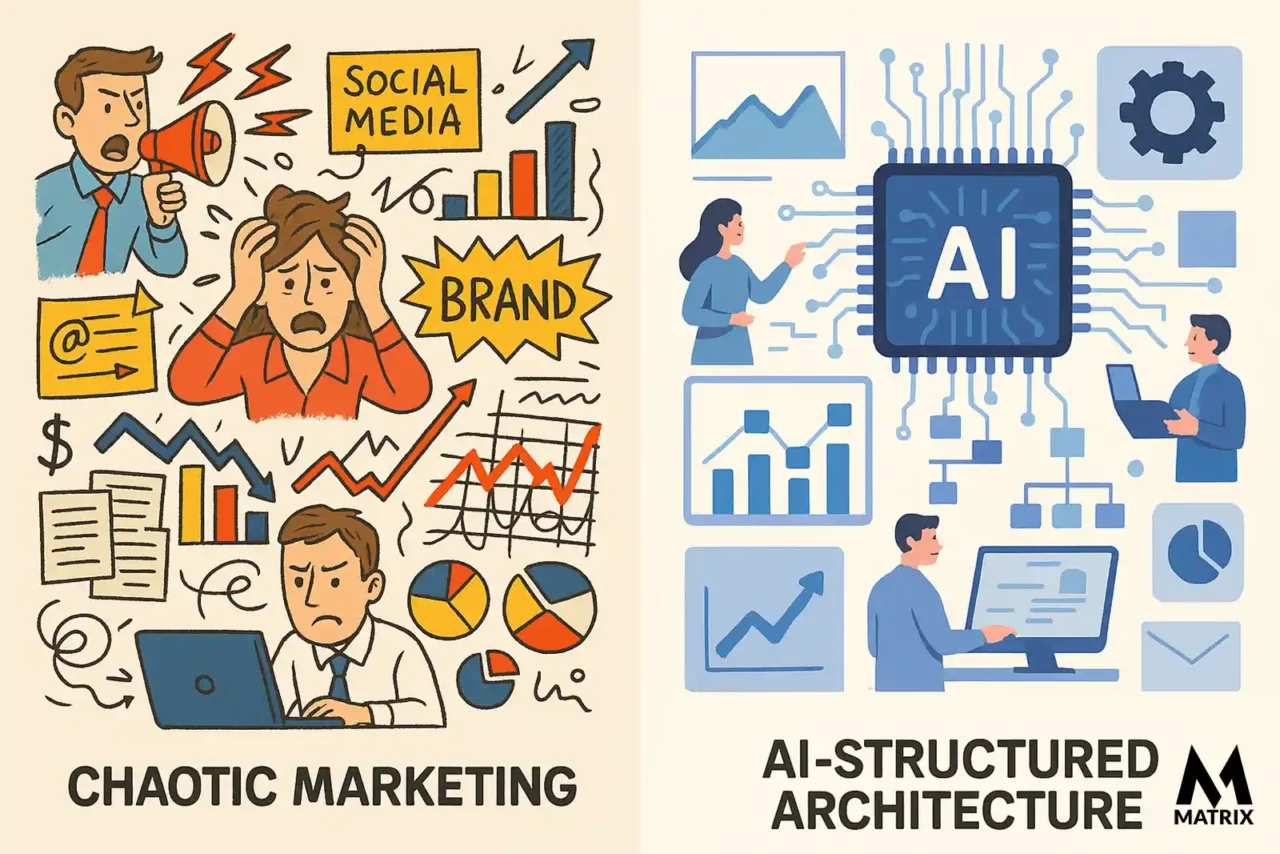The Marketing Manager’s Playbook for AI-Powered Performance Marketing
Learn How To Gain More Sales With The Marketing Manager’s Playbook For AI-Powered Performance Marketing.
You know the feeling. It’s 8:00 PM on a Tuesday, your laptop is still glowing, and you’re staring at a spreadsheet full of performance data. The Cost Per Acquisition (CPA) is up 5% this week. Return On Ad Spend (ROAS) is flat. Your C-suite wants a forecast for next quarter, and your team is already stretched thin just keeping the current campaigns alive.
The pressure is immense. It’s a constant tightrope walk between delivering quantifiable results, managing your team’s bandwidth, and staying ahead of competitors who seem to be moving faster daily.
You’re searching for an edge. Not another fleeting trend or a complex tool that requires a Ph.D. to operate, but a genuine strategic shift. You’re likely searching for terms like “how to improve ROAS,” “PPC automation tools,” or even “AI in marketing” because you’re driven by a mix of ambition to deliver game-changing results and a subtle anxiety about being left behind.
This isn’t just another article about AI buzzwords. This is your playbook. This is your guide to moving from reactive firefighting to proactive, strategic leadership. We will explain exactly how AI in performance marketing works, not from a coder’s perspective, but from a marketing manager’s—yours.
Is Your Marketing Stack Leaving Money on the Table?
Your disconnected tools see pieces of the puzzle. A unified AI platform sees the whole picture. Enter your metrics to quantify the impact of switching to MatrixLabX.
Your Current Metrics
Core Business Inputs
1. Searching
2. Streaming
3. Scrolling
4. Shopping
Your Performance Transformed
| Metric | Your Platform | MatrixLabX | Monthly Lift |
|---|
Total Estimated Annual Gain
$0
from improved conversions and recovered revenue
The Two Rooms That Changed Everything
Ashley felt the weight of the title before she even felt the comfort of her new corner office chair. Chief Marketing Officer. It was the role she’d worked for her entire career, but on her first day at Northwood Manufacturing, it felt less like a trophy and more like a ticking clock.
Northwood was a respected name, built on decades of quality and tradition. But “tradition” had become a gilded cage. Their marketing was a time capsule from 2015: manual, gut-driven, and drowning in a graveyard of spreadsheets that tracked everything and revealed nothing. The ghost of last quarter’s flat sales haunted every hallway conversation.
Her mandate from the CEO was simple and terrifying: “Lead our digital transformation. Make us a leader again.”
The challenge wasn’t just technology; it was people. It was two rooms, specifically.
The First Room: The Marketing Team

The first room was the marketing department’s open-plan workspace. It was filled with talented experts in the Northwood way. When Ashley called her first team meeting to outline her vision for an AI-powered, data-driven future, the air grew thick with fear.
She saw it in their faces.
Mark, her veteran Paid Media Manager, crossed his arms. “So, we’re just supposed to hand over our campaign bidding to a robot?” His question wasn’t aggressive; it was laced with the anxiety of a craftsman being told his hands were no longer needed.
Sarah, a brilliant young content writer, looked down at her notebook. “Does this mean we’ll just edit what an algorithm writes all day?” She feared her creativity, her spark, was about to be outsourced to a machine.
This wasn’t a team of laggards; they were a team afraid of being made obsolete. Ashley knew a top-down decree would shatter morale. She had to transform their fear into purpose.
“I’m not here to replace you,” she said, her voice steady. “I’m here to unleash you. Imagine if Mark didn’t have to spend five hours a day manually adjusting bids and could instead spend that time architecting a high-level competitive strategy. Imagine if Sarah had AI to handle the tedious keyword research and first drafts, freeing her up to develop the big, award-winning campaign ideas we need.”
She wasn’t selling them software. She was selling them a better version of their jobs—a future where they could focus on the strategic, creative work they loved while technology handled the robotic tasks they endured. It was a start, but a fragile one.
The Second Room: The Board of Directors
If the first room was filled with fear, the second was a fortress of skepticism. The boardroom at Northwood was mahogany-paneled and intimidating. The faces around the table were seasoned, sharp, and laser-focused on the bottom line.
When Ashley said “AI-driven transformation,” she could almost hear the wallets snapping shut.
“Ashley,” the CFO said, peering over his glasses. “We appreciate the ambition. But these ‘AI’ projects sound expensive. We’re in the business of making widgets, not funding science experiments. What’s the tangible ROI?”
It was the question she was waiting for. She didn’t respond with buzzwords. She responded with their language: risk mitigation and profit.
“This isn’t a blank check,” she explained. “It’s a phased, data-driven investment. I propose a 90-day pilot program on a single, underperforming product line. We will establish a clear baseline and define success by three metrics only: lead quality, cost per acquisition, and sales revenue. If we don’t hit our targets, we pull the plug. If we do, we have a proven model for growth.”
She wasn’t asking for faith. She was presenting a calculated business case. The board, convinced by her low-risk, high-reward approach, gave her a hesitant green light.
The Ninety Days That Forged a Future
The next three months were a blur of focused execution. Armed with new AI tools and a clear mission, Ashley’s team began the pilot. There were frustrations and learning curves, but magic moments started to happen.
Mark discovered that the AI had identified a new, high-value customer segment they’d never thought to target. Sarah used a generative AI platform to test 50 different ad headlines in a single afternoon, finding a winner that quadrupled their click-through rate. The team wasn’t being replaced; they were being amplified. They started to see the AI not as a threat, but as the most powerful tool they’d ever had.
The day of the board presentation arrived. Ashley walked into the mahogany fortress but wasn’t alone this time. She brought Mark and Sarah with her.
Mark didn’t talk about software; he talked about discovering a new market worth an estimated $3 million. Sarah didn’t talk about algorithms; she presented the winning ad creative and its direct impact on lead generation.
Then, Ashley put up the final slide. The results of the 90-day pilot program.
A hush fell over the room.
The numbers were undeniable. Sales metrics for that single product line were up by 32%. Because AI eliminated wasted ad spending and automated dozens of manual processes, their marketing operating cost was reduced by an astonishing 65%.
They weren’t just saving money but making more money with less effort. The pairing of Matrix Marketing Group’s AI application experience and MatrixLabX product line cuts costs and increases sales.
It was the turning point. The two rooms—the one of fear and the one of skepticism—were finally united in a single room of excitement. The pilot was expanded, and Ashley’s vision became Northwood’s new reality.
Ashley’s story isn’t about technology. It’s about leadership. It’s a story of turning fear into empowerment and skepticism into belief.
It proves that the most powerful digital transformations aren’t about replacing people but unlocking their true potential.
The Core Problem: We’re Drowning in Data, But Starving for Certainty

For the last decade, digital marketing has been about data. We have more of it than we know what to do with. Clicks, impressions, conversions, bounce rates, customer lifetime value—it’s all there. Yet, for all this data, how many of our decisions are still based on educated guesses?
- “Let’s allocate an extra $20k to the summer campaign; it felt like it worked last year.”
- “Let’s A/B test these two headlines and see what happens.”
- “This audience segment seems to be performing well, let’s double down.”
These are the decisions that keep you up at night. They are rooted in experience and intuition, which are valuable. But in today’s hyper-competitive landscape, intuition isn’t enough.
Your search for AI solutions is a search for certainty. The desire to walk into that budget meeting with a data-backed forecast, not just a hopeful hunch.
AI is the bridge from data overload to decisive action. It processes that mountain of information and finds the patterns your human team, brilliant as they are, could never spot on their own.
The Four Core Plays to Run in Your AI-Powered Strategy

Think of this as your offensive playbook. These are the four key areas where AI will have the most immediate and profound impact on your performance marketing ROI.
At Matrix Marketing Group, we’ve built our strategies and proprietary tools at Matrix LabX around these pillars.
Play #1: Predictive Budgeting & ROI Forecasting
- The Pain Point: The quarterly budget guessing game. You’re asked for a concrete forecast, but the market is volatile. You risk overpromising and under-delivering, or under-asking and leaving growth on the table.
- The AI Solution: AI doesn’t guess; it calculates probabilities. Predictive models can accurately forecast outcomes by analyzing your historical campaign data, seasonality, competitor spending patterns, and market trends.
- In Practice: Imagine uploading your last two years of performance data. The AI model identifies that your CPA for a specific keyword cluster historically increases by 15% in Q4, but conversions from a secondary audience segment surge by 30%. The AI then recommends reallocating 10% of your budget from the first cluster to the second, providing a forecasted ROAS 22% higher than your previous strategy.
This is precisely why we developed Predictive ROI™ at Matrix LabX.
It’s a forward-looking intelligence engine. It ingests your past performance and tells you the most probable financial outcome of your future campaigns, allowing you to invest confidently.
Play #2: Generative Creative at Scale
- The Pain Point: The creative bottleneck. Your design and copy team are talented, but can only produce so much. Ad fatigue sets in, and your A/B tests move at a snail’s pace, testing one variable at a time.
- The AI Solution: Generative AI acts as a tireless creative assistant. It can instantly generate hundreds of ad copy variations, headlines, and descriptions based on your core messaging and brand voice. It can even suggest image concepts or create initial visual drafts.
- In Practice: You need new ads for a flash sale. Instead of briefing your team on two headlines and one description, you give a prompt to a generative AI model. In minutes, you have 50 different headline variations, each targeting a slightly different emotional trigger (urgency, exclusivity, savings). You can immediately launch a multivariate test to find the top 1% of performers, which would have taken weeks.
Our Creative Catalyst™ tool from Matrix LabX is designed for this. It generates text and image concepts and analyzes your existing top-performing ads to learn what resonates with your audience, ensuring its creative suggestions are primed for conversion.
Play #3: Hyper-Targeting & True Audience Discovery
- The Pain Point: Wasted ad spend. You’re paying to show your ads to people who will never buy. Your lookalike audiences aren’t performing like they used to, and you feel you’ve saturated your core demographic.
- The AI Solution: AI moves beyond simple demographics. It analyzes thousands of behavioral signals—browse patterns, content consumption, purchase intent signals—to build complex, multi-dimensional audience segments. It finds pockets of high-value customers you never knew you had.
- In Practice: An e-commerce brand selling high-end running shoes targets “marathon runners.” An AI model, however, discovers a hidden, high-converting segment: “physical therapists aged 30-45 who frequently read articles about injury prevention.” This segment has a 3x higher conversion rate. The AI can then build a lookalike audience based on these nuanced behavioral traits, not just broad interests.
This is the power of Audience IQ™ from Matrix LabX, the latest from the team.
It’s a discovery engine that helps you stop targeting who you think your customers are and start targeting who they probably are, dramatically reducing wasted spend.
Play #4: Autonomous Optimization & Anomaly Detection
- The Pain Point: You can’t watch everything 24/7. A campaign can go off the rails overnight due to a technical glitch or a sudden shift in competitor bidding, and you won’t know until the next morning’s report.
- The AI Solution: AI is your always-on campaign sentry. It monitors real-time performance and can be authorized to make autonomous adjustments, like reallocating a budget from an underperforming ad set or pausing a campaign that suddenly shows a spike in fraudulent clicks.
- In Practice: At 2:00 AM, a competitor aggressively bids up a key term, causing your CPA to skyrocket. An AI model detects this anomaly instantly, pauses your bids on that specific keyword, and reallocates the budget to a more profitable secondary keyword, all before your team has had their first coffee. It saves your budget and flags the event for strategic review in the morning.
The Human Element: Your Team Becomes a Team of Strategists

Let’s address the biggest emotional question head-on: “Is AI coming for my team’s jobs?”
The answer is no. AI is coming for the robotic parts of their jobs. It’s coming for the tedious, repetitive, soul-crushing tasks that burn your best people out.
Automating the manual work elevates your team’s role from button-pusher to strategic driver.
| The Role of a Paid Media Specialist | Before AI | After AI |
| Bidding | Manually adjusts bids based on daily reports. | Sets strategic goals and guardrails; AI executes bidding 24/7. |
| Creative | Writes 2-3 ad variations for an A/B test. | Reviews 50 AI-generated variations, selects the top 10 for testing. |
| Reporting | Spends hours pulling data into spreadsheets. | Analyzes an AI-generated dashboard highlighting key insights and anomalies. |
| Focus | 80% tactical execution, 20% strategy. | 20% tactical oversight, 80% high-level strategy and creative direction. |
You are not replacing your team; you are supercharging them. You’re giving them the tools to make a bigger impact, which boosts morale and delivers better results.
Your First 90-Day Playbook for AI Integration
Feeling overwhelmed? Don’t be. You don’t need to flip a switch overnight. Here’s a simple, 90-day plan to get started.
- Month 1: Audit & Benchmark. Don’t start with technology. Start with a question: Where is our biggest opportunity or friction point? Is it wasted spend, creative bottlenecks, or forecasting uncertainty? Establish your baseline metrics (CPA, ROAS, conversion rate).
- Month 2: Launch a Pilot Program. Choose one campaign. Don’t boil the ocean. Pick a campaign with clear objectives and run it using an AI-powered methodology. Test a tool like AIAdPad™ to see if you can find a new, high-value audience segment.
- Month 3: Analyze, Learn, and Scale. Compare the pilot campaign’s results to your benchmark. Did the AI-driven approach lower your CPA? Did it increase ROAS? Use this data to build your internal business case and develop a roadmap for scaling the strategy across more campaigns.

Conclusion: From Manager to Architect
The role of the marketing manager is changing. The future doesn’t belong to the one who can best manage a spreadsheet. The buying cycle is not linear; we argue it never was, maybe in a limited time.
It belongs to the one who can best architect a system of human talent and artificial intelligence to achieve business goals.
By embracing AI, you’re not just optimizing campaigns; you’re optimizing your career. You’re gaining the confidence that comes from certainty, the strategic high ground that comes from insight, and the results that get you noticed. You stop being a campaign manager and become an engine of growth.
Ready to stop guessing and start winning?
The principles in this playbook are the foundation of our work at Matrix Marketing Group. We use the powerful tools from our Matrix LabX innovation hub to deliver unparalleled results for our clients.
Schedule a complimentary AI Readiness Assessment with us today. We’ll analyze your current performance marketing efforts and identify the single biggest opportunity for you to leverage AI for immediate ROI growth.
